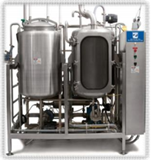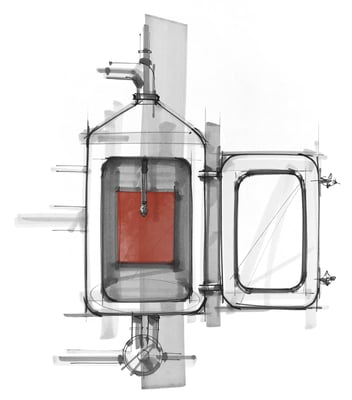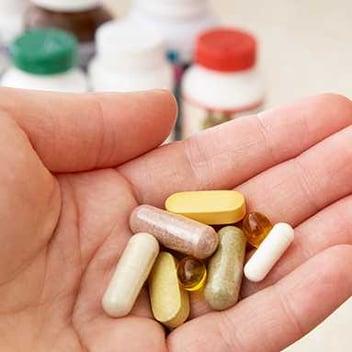How to clean Manufacturing Equipment
In regulated industries, you are not allowed to initiate a production batch unless the Quality Assurance gives you a go-ahead after various checks, including the equipment being visually clean. This means that Cleaning is the First step to manufacturing, not the last.
Over the last two decades, we have seen a rapid growth in development and improvement of Automated Cleaning Systems (Clean-in-place/Wash-in-place). It is also common knowledge that these systems need to be paired with the right detergents for effective and efficient cleaning. However, a lot of equipment are still manually cleaned, posing a question that we intend to answer.
Due to the variations in the shape, size, and cleaning capabilities of different equipment, it is nearly impossible to have a universal cleaning guideline. However, understanding the science behind cleaning and the impact of the TACT (Time, Action, Chemistry & Temperature) parameters will help in reducing optimization trials.
As the material of construction is common in regulated industrial plants (Stainless steel 316 or 304, along with some gaskets, O rings, tubings, etc.), we could generalize a semi-automated or manual cleaning procedure that should be employed for an efficient cleaning process.
Once the lab studies and subsequent Scale-up Studies help us determine the right cleaning chemistry and give us an indication about the cleaning recipe, optimization is to be done on the actual machine to finalize the parameters of a regular cleaning process that can be validated.
1. Pre-rinse:
-
This step is to remove loosely attached residue and/or improve wetting.
-
For some residues, this step might negatively impact the cleaning process and should be skipped based on lab studies.
-
The water needs to be drained off completely before the wash step.
-
The wash step has to be started immediately after the pre-rinse before the residue dries.
2. Detergent step:
-
In an ideal scenario, this step dissolves or breaks the residue into microparticles and suspends the entire residue to avoid redeposition. While the right detergent Chemistry will ensure this, the right cleaning recipe should be developed for higher cleaning efficiency.
-
The temperature, concentration, and contact time will depend on the detergent and residue. A single detergent step is preferable to the use of multiple detergents.
-
The detergent solution must be pre-prepared. In case this is not possible, the concentrated detergent or a partially dilute detergent should be introduced into the equipment first, followed by water addition to ensure that the residue doesn't come in contact with the hot water without the detergent.
-
The entire residue should be soaked for the recommended time period as un-soaked residue might require manual scrubbing or high-pressure cleaning.
-
The more action during soaking, the more efficient is the cleaning. Action such as Spray cleaning, blade/pan movement helps with increased coverage, improved detergent contact, and removal of dissolved or dislodged residue.
-
On completion of this cycle, the solution needs to be drained off completely and cannot be re-used.
-
A repeat detergent cycle might have to be performed if the residue is thick and more than the carrying capacity of the detergent solution quantity in one single cycle.
-
If manual cleaning is done, a quick wipe might be necessary for the parts that have no proper detergent coverage or mechanical cleaning action.
3. Post rinse:
-
Final rinse must be done immediately after the wash step draining to prevent the drying of the detergent solution onto the surface of the equipment as residue & detergent don’t easily go into solution after drying, and may require heavy scrubbing otherwise
-
Ambient water temperatures can be used. The use of hot water helps faster drying in many cases though it could cause flash-drying of the residue if it isn't completely drained off.
-
If pressure wash is possible, it must be utilized to remove all traces of residue and detergent.
-
If possible, the first rinse water is to be drained off and re-rinsing must be done.
-
Depending on the industry, the final rinse is to be done with Purified water as per GMP requirements.
-
Rinsing duration depends on the washing & rinsing procedure as well as the equipment size and should be continued till the water sample is free from any residue.
Depending on other variables like the residue amount, dirty hold time, etc., one or more of these steps may have to be repeated
An ideal optimized cleaning would have minimum repetition of each step, and this may need a change of one or more TACT parameters, i.e., a slight increase of contact time or concentration.
how to clean production-size machines without automated systems in an efficient, safe, and economical way
Dry Diffusion Mixers (V blender, cone blender, octagonal blender)
These equipment are usually not equipped with automated cleaners but may use portable CIP cleaners.
In case automated cleaning is not an option, the best way to clean a blender is:
-
Pre-rinse with water at room temperature manually or by filling it with an optimal quantity of water and rotating it for ~5-10 min or by using a spray hose. Discharge the water after pre-rinse.
-
While the equipment is still wet, introduce the optimal amount of pre-diluted detergent solution at recommended concentration and temperature. Close the equipment and rotate it at a speed (RPM) that gives enough action to support effective cleaning for the recommended contact time.
-
Discharge the detergent solution and immediately begin the post-rinse. Post-rinse could be done in a similar manner to the pre-rinse, but it is more critical as it should completely remove all traces of the residue and the detergent.
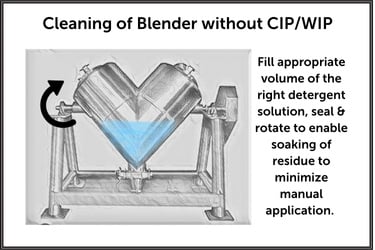 ↵
↵
Wet Mixers/Blenders with mixing elements (Ribbon blenders, paddle mixers, mixing tanks, turbo mixer, rapid mixer & high shear mixer granulator)
This equipment might have an inbuilt automated cleaning system or could use portable CIP cleaners.
If these types of equipment are to be cleaned without automation, the following process could be used:
-
Pre-rinse water at room temperature manually or by filling the mixer with an optimal quantity of water and rotating the mixing elements for ~5-10 min. Discharge the water after pre-rinse.
-
Immediately fill the mixer with pre-diluted detergent solution manually or by using a hose at recommended concentration and temperature. Close the equipment and rotate the mixing element at a high RPM to improve cleaning action for the recommended contact time.
-
Post rinse procedure should be done immediately and would be similar to pre-rinse step but could also be performed as a 2-step process or with manual spray with draining to ensure complete removal of detergent & residue.
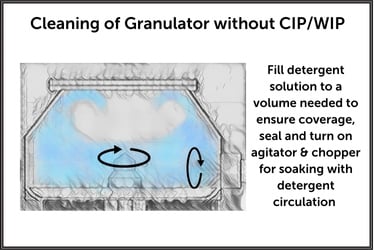 ↵
↵
Coating pans (Non-perforated and perforated)
Most coating pan manufacturers offer inbuilt CIP/WIP systems in the new equipment at an added cost. The older machines may not have such a system or might have a sub-optimal WIP system with lower detergent concentration capability or lower pressures. A good spray action helps cleaning efficiency in a coating pan to a large extent as most of the residues in coating pans would be polymers, pigments, or other film-forming products, which are generally difficult to clean.
Cleaning procedure without an automated system would include the following steps:
-
Pre-rinse by manually spraying water using a hose with simultaneous draining. If cleaning of the coating pan housing is needed for perforated coaters, the drain valve could be closed during the rinsing process for better wetting.
-
Add pre-diluted detergent solution at the recommended temperature and concentration. If this is not possible, add the detergent first, followed by the water. Soak the residue on the equipment for the recommended time. The best way to soak will be to fill the pan with detergent solution till the baffles are submerged and rotate the pan at high pan speed for maximum action and splashing to the back walls.
-
Drain the detergent solution and post-rinse could be done using a hose spray with soaking or draining.
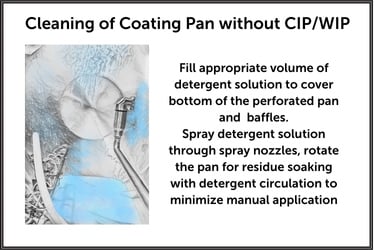 ↵
↵
Reactors/Large tanks - Equipment where fill, soak, and agitation is not possible (Fluid bed equipment, bioreactor, spray driers, Hot melt extruder (HME), filling equipment, tubings)
Without automated cleaning, soil removal from such machines is very tough. Traditional methods call for manual application of detergent on the equipment surface followed by scrubbing. This process is not only a hazard for the operator but also highly inefficient as it cannot utilize the Time and Temperature of the TACT parameters.
- Pre-rinsing could be done by wetting the equipment surface using a hose pipe.
- Detergent step: Depending on the equipment, we need to think out of the box and get creative in developing a cleaning recipe for such machines.
It is to be ensured that the Detergent contact time on all sections of the equipment is as recommended.
This is not the same as applying detergent on the surface and waiting because if the use of hot detergent solution is recommended, it will cool almost immediately on application or may dry on the residue before it can dissolve or loosen the residue.
Also, the small amount of detergent applied would saturate easily with the residue and will not be able to clean the entire soil.
-
One way to achieve adequate soaking time is by installing spray balls in the equipment that has adequate coverage of the entire surface. To soak the residue and keep it wet without wasting a lot of detergent solution, intermittent spraying could be utilized
-
For machines that can spray solutions like the spray drier or fluid bed equipment, the coating spray system can be used to spray the detergent solution.
-
For tubes, detergent can be circulated long enough to dissolve the soil, and HME filled and soaked for some time before manual scrubbing.
-
- The post-rinse for such equipment would have to be done in a similar manner to the detergent cleaning step or with manual spray using a hose depending on whether the equipment is to be cleaned from the bottom or the top
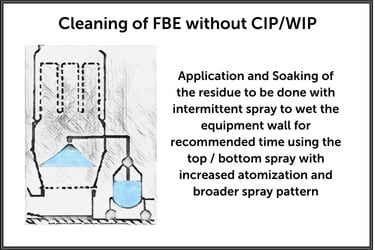
The right Detergent cleans surfaces as long as it is in contact with the residue for adequate time at the recommended parameters. Action is required to remove the dissolved/loosened residue and to replace the supersaturated detergent solution so that it can act on the next layer of residue, like stirring with a spoon helps faster dissolution of sugar. This knowledge, when applied on different machines, helps develop the right recipe. However, Dober offers complete support to develop a cleaning recipe customized to your equipment to reduce your optimization planning and trials.



